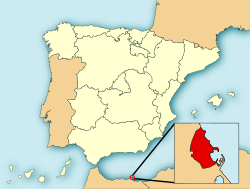
Back Melilla Afrikaans Melilla ALS ሜሊያ Amharic Melilla AN مليلية Arabic مليلية ARY ميلييا ARZ মেলিলা Assamese Melilla AST Melilya Azerbaijani
Melilla
Mřič | |
|---|---|
 Location of Melilla in Spain | |
| Coordinates: 35°18′N 2°57′W / 35.300°N 2.950°W | |
| Country | Spain |
| Government | |
| • Mayor-President | Juan José Imbroda (PP) |
| Area | |
• Total | 12.3 km2 (4.7 sq mi) |
| • Rank | 19th |
| Population (2018)[1] | |
• Total | 86,384 |
| • Rank | 18th |
| • Density | 7,000/km2 (18,000/sq mi) |
| • Rank | 1st |
| • % of Spain | 0.16% |
| Demonyms | Melillan |
| GDP | |
| • Total | €1.756 billion (2022) |
| • Per capita | €20,698 (2022) |
| Time zone | UTC+01:00 (CET) |
| • Summer (DST) | UTC+02:00 (CEST) |
| ISO 3166 code | ES-ML |
| Official languages | Spanish |
| Statute of Autonomy | 14 March 1995 |
| Parliament | Assembly of Melilla |
| Congress | 1 deputy (of 350) |
| Senate | 2 senators (of 264) |
| Currency | Euro (€) (EUR) |
| Website | www.melilla.es |
Melilla (/mɛˈliːjə/ mel-EE-yə, Spanish: [meˈliʝa] ; Tarifit: Mřič) is an autonomous city of Spain on the North African coast. It lies on the eastern side of the Cape Three Forks, bordering Morocco and facing the Mediterranean Sea. It has an area of 12.3 km2 (4.7 sq mi). It was part of the Province of Málaga until 14 March 1995, when the Statute of Autonomy of Melilla was passed.
Melilla is one of the special territories of the member states of the European Union. Movements to and from the rest of the EU and Melilla are subject to specific rules, provided for inter alia in the Accession Agreement of Spain to the Schengen Convention.[3]
As of 2019, Melilla had a population of 86,487.[4] The population is chiefly divided between people of Iberian and Riffian extraction.[5] There is also a small number of Sephardic Jews and Sindhi Hindus. Melilla features a diglossia between the official Spanish and Tarifit.[6]
Like the autonomous city of Ceuta and Spain's other territories in Africa, Melilla is subject to an irredentist claim by Morocco.[7]
- ^ Municipal Register of Spain 2018. National Statistics Institute.
- ^ "Contabilidad Regional de España" (PDF). www.ine.es.
- ^ Council of the European Union (2015). The Schengen Area (PDF). Council of the European Union. doi:10.2860/48294. ISBN 978-92-824-4586-0.
- ^ "Cifras oficiales de población resultantes de la revisión del Padrón municipal a 1 de enero". Instituto Nacional de Estadística. Retrieved 26 June 2020.
- ^ Trinidad 2012, p. 962.
- ^ Sánchez Suárez 2003, p. 190.
- ^ Trinidad 2012, pp. 961–975.




